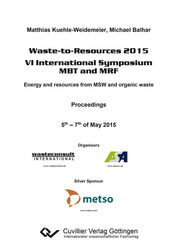| Fachbereiche | |
|---|---|
| Buchreihen (96) |
1378
|
| Nachhaltigkeit |
3
|
| Gesundheitswesen |
1
|
| Geisteswissenschaften |
2363
|
| Naturwissenschaften |
5406
|
| Mathematik | 229 |
| Informatik | 319 |
| Physik | 980 |
| Chemie | 1363 |
| Geowissenschaften | 131 |
| Humanmedizin | 243 |
| Zahn-, Mund- und Kieferheilkunde | 10 |
| Veterinärmedizin | 108 |
| Pharmazie | 147 |
| Biologie | 835 |
| Biochemie, Molekularbiologie, Gentechnologie | 121 |
| Biophysik | 25 |
| Ernährungs- und Haushaltswissenschaften | 45 |
| Land- und Agrarwissenschaften | 1004 |
| Forstwissenschaften | 201 |
| Gartenbauwissenschaft | 20 |
| Umweltforschung, Ökologie und Landespflege | 148 |
| Ingenieurwissenschaften |
1791
|
| Allgemein |
98
|
|
Leitlinien Unfallchirurgie
5. Auflage bestellen |
|
Erweiterte Suche
Waste-to-Resources 2015
VI International Symposium MBT and MRF
Michael Balhar (Herausgeber)Matthias Kühle-Weidemeier (Herausgeber)
Vorschau
Inhaltsverzeichnis, PDF (120 KB)
Leseprobe, PDF (320 KB)
The Sugarcane Industry in Brazil is responsible for generation of different types of organic wastes. Bagasse and small share of straw have already been used as solid fuel in cogeneration systems in general. Meanwhile, there are other kinds of by-products, as filter cake and vinasse, which have been completely unused from the energy point of view. The idea of converting such unused wastes into additional energy is gaining attention, especially driven by some Government commitments on increasing the renewable energy generation combined with the reduction of carbon dioxide emissions.
The anaerobic digestion process is able to contribute with additional renewable energy production, in the form of electricity from biogas or even biomethane, keeping meanwhile the current practice of recycling the nutrients contained in these wastes on the sugarcane fields. However, for a successful application in industrial scale, the anaerobic digestion process must be carefully evaluated in terms of selection of appropriate inoculum, process kinetics, and plant design, among other aspects.
| ISBN-13 (Printausgabe) | 9783954049813 |
| ISBN-13 (E-Book) | 9783736949812 |
| Buchendformat | A5 |
| Sprache | Englisch |
| Seitenanzahl | 682 |
| Umschlagkaschierung | glänzend |
| Auflage | 1. Aufl. |
| Erscheinungsort | Göttingen |
| Erscheinungsdatum | 17.04.2015 |
| Allgemeine Einordnung | Proceeding |
| Fachbereiche |
Umweltforschung, Ökologie und Landespflege
|








